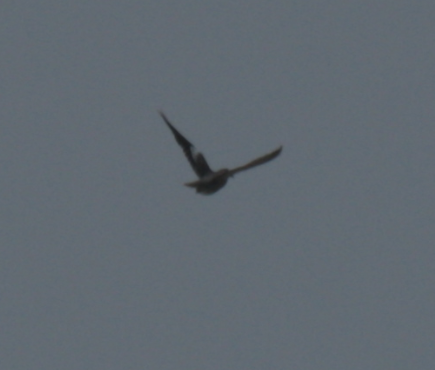Like Mordialloc, there was nothing of interest recently reported (or ever, too be quite honest), but there was something compelling about a bit of seawatching. There was also a hiking trail in the back, though not a long one as I soon found out.
I saw my first breeding plumage Brandt's cormorants today, intermingled with a scattering of pelagic and double-crested cormorants as well. All of the aforementioned birds were located on this rocky outcrop a few metres out to sea. My first surprise was a grey wader that flew by and hopped onto the rocks, a wandering tattler, which was a new tick for me though it did not stay for long. Cruising past the rocks were a few royal terns, a lone caspian tern, the typical gulls and pelicans, and an probably black-vented shearwater that was too far out to identify.
 |
| Wandering tattler with double-crested cormorant (left) and Brandt's cormorant (right). Don't ask what the background cormorant is, no idea! |
*(flight snapshot is a term I've developed referring to the "frozen" images you see of butterflies in flight when they are nearby. Presumably because the human eyes cannot detect the swift motion of the butterfly wings in flight properly, there is often some "lag" in what is seen. Such snapshots allow the observer to see "flashes" of the markings and colouration of the upper wings as if it was perched still. Otherwise the blurring motion of white butterflies would be just that, a white blur.)
When they finally landed the mystery was resolved; they were Becker's whites, a very localized species that I had only seen once before. Though similar to both checkered and western whites, the markings, particularly the underside ones, are much bolder and the central spot on the front wings is bigger and wider.
 |
| Male Becker's white. |
 |
| Good |
 |
| Better |
 |
| Best. |
I was able to spot some nice bee flies as well. I usually only see 2 or 3 varieties per outing, but I had at about 6-7 species here, many of which I have never seen before.
 |
| One of many bee flies, this one is the relatively distinctive Poecilanthrax arethusa. |
At about 2pm back along the coast a "probable feral rock pigeon" flew over my head, easily told from the small, long-tailed mourning dove by its large size and short tail. A few seconds passed and it flashed white in its wings, something not originally visible from the underside view I first observed when it flew overhead. That changed everything; this common bird often considered a pest quickly morphed into a rarity for this area in the form of white-winged dove, a desert bird usually found quite far to the south from here. While rare, multiple records exist of its wandering along this coastline, so it is clearly quite migratory in nature, albeit in the wrong direction. This bird landed on the west cliff, about 2 metres from people on the beach (you bet I wish I was standing there) before flying off around the coastline again before I could walk more than 3 steps.
 |
| The white wing patch on this white-winged dove is quite visible even with the naked eye. The long bill (for a dove) is not seen here but it is obvious in other images. |
No, not a bad trip at all. I'm starting to like these family beach trips.
No comments:
Post a Comment